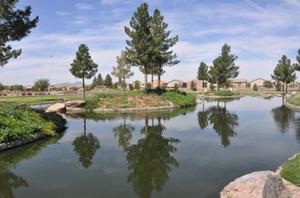
Concrete is a recipe, a fine-tuned mix of cement, water and aggregates designed to act as a lifelong foundation for homes, block walls and more.
However, when the recipe is not formulated to the specific environmental influences of an area, it can raise questions about the long-term structural integrity.
“We want to know our homes are built on a solid foundation and will last a lifetime,” said Maricopa resident David Williams. Williams is one of more than 600 homeowners in the Maricopa Meadows community who has submitted a claim against eight homebuilders: Brown Family Communities, Courtland Homes, Elite Communities, Frontier Homes, HomeLife Communities, KB Home, Richmond American Homes and Standard Pacific Homes.
The claim alleges the builders of roughly 1,600 homes were negligent in their building practices because they did not use concrete mixes that were resistant to the high sulfate concentrations present in the soils in the community.
Crumbling foundations
The concern revolving around the sulfates in the soil is that they are causing concrete structures to crumble.
“I have talked to my geotechnical expert, and he said the sulfate levels in the Meadows were 1,000 times the acceptable level,” said Richard Gramlich, a Phoenix-based attorney who is representing nearly 50 of the homeowners.
The basic science behind the situation is when the soil becomes moist, sulfates dissolve in the water and are then absorbed by the concrete. As the sun dries the moisture from the concrete, the sulfates are left behind to break down the cement holding the materials together.
Jim Wilson, who has worked as a consulting engineer for 40 years in Arizona, said it is important for people to realize this is not a chemical reaction.
“When people hear chemical, they tend to get scared; this is a mechanical action that fatigues the concrete,” he said. Wilson said sulfates occur naturally in the soil, and in Arizona they tend to be found in higher concentrations in previously undisturbed desert land.
One resident who has witnessed the damage firsthand is Michelle Leu. Leu moved to the Meadows three years ago and has watched her back patio wither away.
“I have had the developer out two times; all they do is pour some new cement, and then it just crumbles away again,” she said. “I am extremely disappointed to find the developer knew about the issue.”
The home is the first for Leu, who has managed to keep her home despite losing her job, experiencing a reduction in income and a separation. “I honestly don’t know what I am going to do about the situation; I was committed (to keeping the house) until I found out about this foundation problem,” she said.
The issue of high sulfates not only affects these two homes, but all of the nearly 1,600 homes built in the Maricopa Meadows subdivision, according to John Chaix, who represents nearly 90 percent of the homeowners in the claim.
“If the homes in the community are left as is, they would see structural damage in 10 to 15 years,” he said. “It is important to address this issue now.” However, others have a slightly different opinion.
“The damage done by sulfates is superficial to the structural integrity of a home, and there should be no reason for a scare,” Wilson said. “A home in high sulfate soils should last more than 100 years.”
Realistic expectations
Two experts, Adam Neville and Robert Tobin, agree that homeowners should be realistic about their level of concern regarding sulfates.
Neville, who has acted as an expert witness in more than 20 sulfate cases and written books on the subject, including “Properties of Concrete,” said despite numerous allegations about damaged foundations in California, not a single collapse has been reported nor has any structure been evacuated.
His counterpart, Tobin, who has 66 years of experience as a structural engineer, said in testimony that sulfate damage has been observed similar to what might occur due to freeze-thaw weather conditions on exposed concrete, but not a single instance of a progressive attack or a complete failure due to sulfate attack in the true meaning of the word.
He added he has observed surface sulfate incrustations on concrete in and around regions of California, Montana and Wyoming. In these areas of low relative humidity and low rainfall, the natural moisture in the soil dissolves the available sulfates, and when the water evaporates at the surface, a white deposit of sulfate minerals remains on the ground surface. These are referred to as “alkali flats.” Similar behavior can be observed in concrete that was placed on the ground without a protective plastic moisture barrier, but this is not damage.
“The mere fact there is sulfate may or may not be a concern,” Neville said. “A pile of dry sulfate will do nothing to a home, but, when you add moisture, then it may start to damage the foundation.”
Vital factors
While moisture is one of the ingredients that causes sulfate damage, it is not the only factor.
“You have to look at the PSI (pounds per square inch) of the concrete and what type of cement is used,” Neville said. The PSI determines how much weight concrete can withstand, and it is a number that is typically varied by adding or subtracting water to a concrete mix.
“With a higher PSI concrete, the ability for the material to seep in moisture is decreased, thus lessening the likelihood of sulfate attack,” Chaix said. In Maricopa Meadows the slabs were constructed using concrete with a PSI of 2,000 to 3,000; Chaix challenges they should have been constructed using a PSI of 5,000.
“It is a substandard building practice,” Chaix said. While a denser concrete would greatly reduce moisture seeping into the concrete, the use of a different type of cement would have also helped to mitigate the issue, he added.
Cement is the glue that binds concrete together and comes in several different varieties. In the Meadows, Type II cement was used, which is more vulnerable to sulfate attacks than its Type V counterpart.
The importance of using Type V cement should not be underestimated. The Bureau of Land Reclamation’s manual stated in 1985: “Concrete containing cement with a low content of the vulnerable calcium aluminates is highly resistant to attack by sulfate laden soils and water.”
Even though it is common practice to use these sulfate-resistant building practices, they are not required by the building codes that govern the county and city, according to both Pinal County spokesperson Heather Murphy and city of Maricopa Development Services Director Brent Billingsley.
“Some of the work we have contains soil testing, and some does not,” Billingsley said. Wilson added it is good practice for a developer or a homeowner to test for sulfates in the soil.
Warranty and a fix
In Arizona homeowners are protected by an implied eight-year warranty on the structural integrity of their home.
“In Arizona you only have eight years to file a claim, and most of these homes are already four to five years old,” Chaix said. However, Spencer Camps, spokesman for the Home Builder Association of Central Arizona, said that once a lawyer gets involved in the proceedings the dialogue typically slows down.
“In Arizona you are required to file a notice to cure, which requires homeowners to notify the builder they have problem,” Camps said. “It is a 90-day process that allows the builder to examine whether a legitimate issue exists and offer a solution to the issue.
Rarely do these types of things come to litigation, and, if that is the case, the problem usually isn’t fixed for two to three years.”
“The eight builders in the Meadows were all served their notice to cure three weeks ago and have 60 days to offer an initial response,” Chaix said in a May interview. “We have been in contact with several of these builders, and it appears only one is willing to work with its customers.”
That builder is Standard Pacific. In the past year Standard Pacific has treated the foundations of 60 of the 114 homes it has in the Meadows with a sealant. The sealant is applied to the foundation like paint and keeps moisture from penetrating the concrete.
“We are willing to do whatever it takes to ensure the satisfaction of our customers,” said Pat Moroney, the company’s Arizona division president.
Moroney said when his company purchased the lots from Miller Holdings, a test was not done for sulfate concrete, nor was it a common practice to do so at the time.
To show that commitment to the homeowners in the Meadows, Standard Pacific held a meeting with its customers last month to address the issue firsthand. Williams was one of the residents who attended.
“If they can come up with a solution to the problem that is going to work, we and the other Standard Pacific homeowners will be dropped from the claim,” Williams said.
The lawyers representing the clients are hoping the other builders step to the plate and provide the money required to fix the existing and any future damage.
Yet they have been slow to respond. Christian Price, president of the community’s homeowners association, said when the issue first appeared the management company set an appointment with HomeLife Communities.
“They showed and said they can’t do anything to help,” Price said. While they wait, homeowners can help prevent damage by limiting the amount of water that comes into contact with their homes.
“Rain gutters can really help mitigate moisture near the foundation,” Neville said.
Homeowners association
While builders in the subdivision still have time to respond, the clock is ticking on the developer, Miller Holdings. According to a claim by the HOA, Miller Holdings is responsible for the damage in the common areas.
“The situation was brought to our attention about a year and a half ago so we hired a geotechnical engineer to look at the makeup of the soil,” Price said. “We are responsible for the common areas; if they come crashing down, we would be held at fault.”
Price said, when those results came back, the damage was compared to that seen in communities 30 years old.
Chaix is representing the HOA and said he is in the process of assessing the damage and should have a figure available soon. In both the case of the HOA and the homeowners, he said insurance polices will be the target to acquire the money to perform repairs.
“Typically, an insurance policy of this scope has a policy limit of $1 million, so with nine possible defendants, I am not concerned about running out of insurance,” he said. Another issue Chaix will have to address through the process is the 2008 bankruptcy of one of the largest builders in the community, Elite Homes.
“We will have to file to get the stipulation lifted that prohibits any future or pending payments being made by the developer through its insurance policy, but it is a fairly standard practice,” Chaix said.
City investigates
While lawyers are preparing their claims, the city of Maricopa has also been looking into the issue at the Meadows and several other communities. The city became aware of citizen concerns regarding potential problems with the soil in Maricopa Meadows in March, said spokeswoman LaTricia Woods.
Since then, Woods said the city has sifted through documents at both the city and county levels in attempt to find any information regarding the soil content of the subdivision. Despite all of its research, the city has yet to find any documentation of testing for sulfates in the community.
To further investigate, the city hired a geotechnical engineering company to prepare an independent, scientific study of the soils in that area. The results of that study are expected out this month.
“We want the residents of Maricopa to know that the city is not only aware of this potential issue but is working diligently to gather information concerning this matter,” Woods said. “If you are concerned about this problem on your property, we encourage you to do your own additional research as it pertains to your specific home and determine what potential remedies are available to you.”
Valuation and resale
With many concerned about the long-term viability of their homes, other issues have come up regarding home valuation. “This is absolutely going to impact home values and reselling potential in the area,” Chaix said.
John Kamouzis, part owner of Prudential One Realty, said his team has already begun disclosing that there may be an issue in the Meadows regarding its soil.
“I don’t think the severity of the issue is quite clear yet, but we are required by law to let potential buyers know of any issues a home may have,” he said. He said the disclosure notice has been somewhat disconcerting to those looking to buy in the area, but homes are still selling. “It is a nice place; I hope they can work out the issues.”
Steve Murray, owner of The Maricopa Real Estate Company, said he’s still taking listings in the community; however, he’s seeing investor interest in the area fall off.
While homes may be moving at a slower pace, John Saggio, who has been appraising homes for more than 30 years, said he does not think the issue will affect the value of homes in the area.
“The homes are priced so low right now, I don’t think anything could bring them lower. You can’t buy land for the price of many of these homes.”
(A version of this story appeared in the June issue of InMaricopa News.)
Photo by Jim Williams

![3 things to know about the new city budget Vice Mayor Amber Liermann and Councilmember Eric Goettl review parts of the city's 2024 operational budget with Mayor Nancy Smith on April 24, 2024. [Monica D. Spencer]](https://www.inmaricopa.com/wp-content/uploads/2024/04/spencer-042424-preliminary-budget-meeting-web-218x150.jpg)






![MHS G.O.A.T. a ‘rookie sleeper’ in NFL draft Arizona Wildcats wide receiver Jacob Cowing speaks to the press after a practice Aug. 11, 2023. [Bryan Mordt]](https://www.inmaricopa.com/wp-content/uploads/2024/04/cowing-overlay-3-218x150.png)



![Alleged car thief released without charges Phoenix police stop a stolen vehicle on April 20, 2024. [Facebook]](https://www.inmaricopa.com/wp-content/uploads/2024/04/IMG_5040-218x150.jpg)

![3 things to know about the new city budget Vice Mayor Amber Liermann and Councilmember Eric Goettl review parts of the city's 2024 operational budget with Mayor Nancy Smith on April 24, 2024. [Monica D. Spencer]](https://www.inmaricopa.com/wp-content/uploads/2024/04/spencer-042424-preliminary-budget-meeting-web-100x70.jpg)


